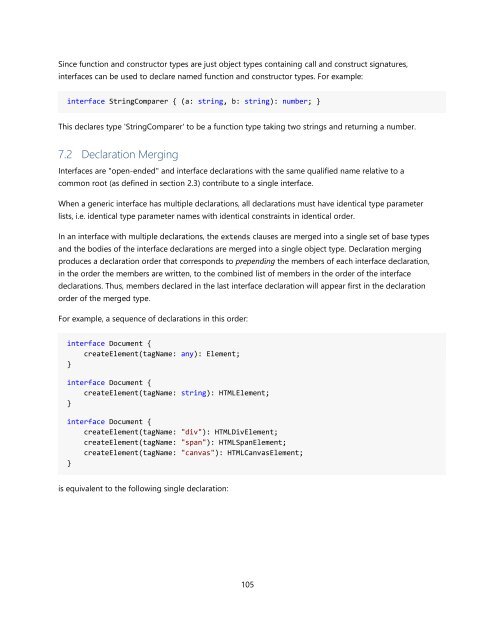TypeScript Language Specification v1.5
TypeScript Language Specification v1.5
TypeScript Language Specification v1.5
Create successful ePaper yourself
Turn your PDF publications into a flip-book with our unique Google optimized e-Paper software.
Since function and constructor types are just object types containing call and construct signatures,<br />
interfaces can be used to declare named function and constructor types. For example:<br />
interface StringComparer { (a: string, b: string): number; }<br />
This declares type 'StringComparer' to be a function type taking two strings and returning a number.<br />
7.2 Declaration Merging<br />
Interfaces are "open-ended" and interface declarations with the same qualified name relative to a<br />
common root (as defined in section 2.3) contribute to a single interface.<br />
When a generic interface has multiple declarations, all declarations must have identical type parameter<br />
lists, i.e. identical type parameter names with identical constraints in identical order.<br />
In an interface with multiple declarations, the extends clauses are merged into a single set of base types<br />
and the bodies of the interface declarations are merged into a single object type. Declaration merging<br />
produces a declaration order that corresponds to prepending the members of each interface declaration,<br />
in the order the members are written, to the combined list of members in the order of the interface<br />
declarations. Thus, members declared in the last interface declaration will appear first in the declaration<br />
order of the merged type.<br />
For example, a sequence of declarations in this order:<br />
interface Document {<br />
createElement(tagName: any): Element;<br />
}<br />
interface Document {<br />
createElement(tagName: string): HTMLElement;<br />
}<br />
interface Document {<br />
createElement(tagName: "div"): HTMLDivElement;<br />
createElement(tagName: "span"): HTMLSpanElement;<br />
createElement(tagName: "canvas"): HTMLCanvasElement;<br />
}<br />
is equivalent to the following single declaration:<br />
105


















